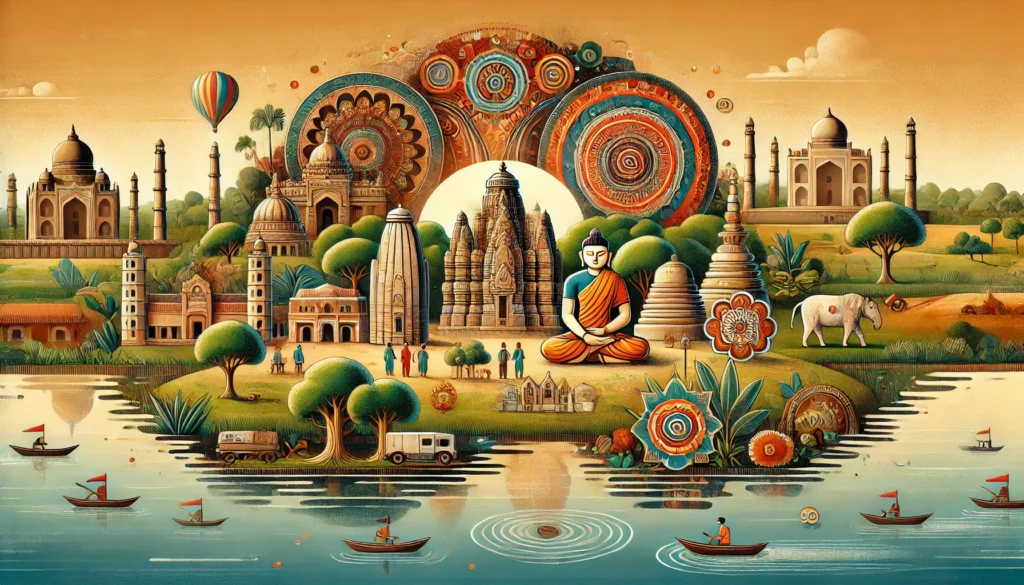
Bihar, located in eastern India, is a state rich in culture, history, and natural beauty. Comprising 38 districts, each region of Bihar has its unique charm and significance. In this article, we take you on a journey across the districts of Bihar, sharing an interesting highlight about each one.
1. Araria
Known for its scenic beauty, Araria boasts picturesque landscapes and a tranquil environment. The district is also a gateway to Nepal, making it a hub for cross-border trade and tourism.
2. Arwal
A relatively new district, Arwal is significant for its historical and cultural contributions, with its roots tied to ancient Magadha.
3. Aurangabad
Often referred to as the “Chittorgarh of Bihar,” Aurangabad is known for its historical forts and its rich tradition of education and bravery.
4. Banka
Home to the famous Mandar Hill, Banka is steeped in mythological significance and is a prominent site for Hindu and Jain devotees.
5. Begusarai
Begusarai is often called the “Industrial Capital of Bihar,” with a vibrant economy and a rich cultural heritage.
6. Bhagalpur
Known as the “Silk City,” Bhagalpur is renowned for its exquisite silk fabrics and the majestic Vikramshila ruins.
7. Bhojpur
Bhojpur is famous for its historical significance and the stunning Shiva temple at Arrah, a masterpiece of ancient architecture.
8. Buxar
A land of legends, Buxar is where Lord Rama is believed to have performed the “Tarakasura” slaying, making it a spiritual hotspot.
9. Darbhanga
Known as the “Cultural Capital of Bihar,” Darbhanga is a hub for Maithili culture, art, and music.
10. East Champaran
The birthplace of Gandhi’s Champaran Satyagraha, this district is a symbol of India’s fight for independence.
11. Gaya
One of the holiest cities for Hindus and Buddhists, Gaya is home to the Mahabodhi Temple, a UNESCO World Heritage Site.
12. Gopalganj
Known for its fertile lands, Gopalganj is a prominent agricultural hub in Bihar.
13. Jamui
Jamui has deep roots in Jain history and is home to many ancient temples and archaeological sites.
14. Jehanabad
A district known for its fertile land and rich agricultural output, Jehanabad also has historical significance tied to ancient Magadha.
15. Kaimur
Nestled in the Kaimur Hills, this district is a paradise for nature lovers and history enthusiasts, with sites like the Kaimur Wildlife Sanctuary.
16. Katihar
Famous for its jute production, Katihar is a key industrial district in Bihar.
17. Khagaria
Located near the Kosi River, Khagaria is an important agricultural district with scenic riverine landscapes.
18. Kishanganj
A beautiful district with lush green tea gardens, Kishanganj also has historical and religious significance.
19. Lakhisarai
Rich in history, Lakhisarai is home to ancient stupas and temples, reflecting its glorious past.
20. Madhepura
Madhepura is an emerging district known for its contribution to India’s rail industry, hosting a locomotive factory.
21. Madhubani
World-famous for its Madhubani paintings, this district is a vibrant center of art and culture.
22. Munger
Renowned for its yoga tradition and the iconic Munger Fort, this district is a blend of spirituality and history.
23. Muzaffarpur
Known for its delicious lychees, Muzaffarpur is often called the “Lychee Kingdom of India.”
24. Nalanda
Home to the ancient Nalanda University, this district is a symbol of Bihar’s scholarly heritage.
25. Nawada
A peaceful district with natural beauty and historical significance, Nawada is known for its scenic hillocks and ancient temples.
26. Patna
The capital city of Bihar, Patna, is a historic metropolis with landmarks like the Golghar and the Gandhi Maidan.
27. Purnia
Known as the “Green City of Bihar,” Purnia is an agricultural hub with lush green landscapes.
28. Rohtas
Famous for the majestic Rohtasgarh Fort, this district is a haven for history buffs.
29. Saharsa
A district that flourishes with its agricultural output, Saharsa is known for its proximity to the Kosi River.
30. Samastipur
Samastipur is an important rail junction and is known for its thriving agricultural industry.
31. Saran
Saran is famous for the Ashokan pillar at Vaishali and its contribution to Bihar’s historical legacy.
32. Sheikhpura
This scenic district is dotted with small hillocks and is a hub for serenity and natural beauty.
33. Sheohar
A small yet vibrant district, Sheohar is known for its agricultural prosperity and community harmony.
34. Sitamarhi
The birthplace of Goddess Sita, Sitamarhi holds immense religious significance for Hindus.
35. Siwan
A district with a rich historical and cultural background, Siwan has produced many notable personalities.
36. Supaul
Supaul, with its serene landscapes and proximity to Nepal, is a district of strategic importance.
37. Vaishali
The birthplace of Lord Mahavira and a center for ancient democracy, Vaishali is a gem of historical and spiritual significance.
38. West Champaran
Home to the Valmiki National Park, this district is a biodiversity hotspot and a paradise for wildlife enthusiasts.
Conclusion
Bihar’s 38 districts together create a rich tapestry of culture, history, and natural beauty. Each district has its unique story to tell, from ancient traditions to modern developments. Whether you are a history buff, a nature lover, or someone exploring spiritual destinations, Bihar offers something for everyone.
Visit Bihar.cc for more insights into Bihar’s rich heritage and vibrant districts. Share your experiences and explore the incredible diversity of this remarkable state!
